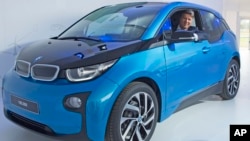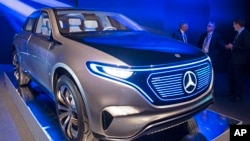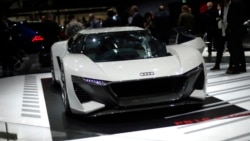The world’s top automakers are increasingly offering more electric vehicle models, as they steadily back away from gasoline engines. This growth is expected to continue, with more people choosing to hit the road with clean-running electric-powered cars.
Environmentalists have praised the automakers for taking major steps to limit harmful pollutants linked to worldwide climate change.
But electric vehicles are also known for not producing another kind of pollution – noise. They run on batteries instead of fuel, and can operate in silence.
While many people might consider this a good thing, quiet cars can also cause problems. The main danger is that people walking in areas around electric vehicles face a greater risk of being hit if they cannot hear the cars coming.
Governments in the United States and Europe have recognized this problem. So, they have set requirements for manufacturers to add warning sounds to vehicles operating on electricity.
The U.S. Department of Transportation finalized its rules a year ago. The rules require electric and hybrid vehicles to be equipped with some kind of warning sound when moving at speeds up to 30 kilometers per hour. The rules are aimed at preventing injuries among people walking or riding bicycles and to protect the blind.
So what kinds of sounds can we expect to hear from the next generation of electric vehicles? While the development of such sounds is ongoing, some manufacturers have released examples of their car noise creations.
That sound, released last year, was created for Jaguar’s electric I-Pace vehicle.
Of course, one of the easiest solutions would be for carmakers to simply reproduce the sound a car would make if it actually did run on fuel. But many industry officials believe this would be a mistake. They say this would not support the electric vehicle’s true identity. It would also limit great possibilities to link the car’s sound to a whole new image, which could help increase sales.
Representatives from some major automakers spoke about the issue this week ahead of the Geneva International Motor Show in Switzerland.
Frank Welsch is head of technical development at Germany’s Volkswagen. He told Reuters that finding the perfect sound mix is not an easy process.
“The electric vehicle sound is its identity,” he said. “It cannot be too intrusive or annoying. It has to be futuristic and it cannot sound like anything we had in the past.”
Welsch said Volkswagen’s electric cars will have special speakers designed to get attention. The company is developing different sounds to correctly fit the size, make and overall image of each model, he added. For example, he said high-performance models and larger vehicles would have more bass added to their sound.
An official from German competitor Mercedes-Benz said the company had developed a noise for its new EQC model. The official said the sound was designed to provide a safe warning without annoying passengers inside the vehicle. Developer Jochen Hermann said the goal was to create a car that remains completely quiet on the inside, but fills the sound requirements and supports the model’s image on the outside.
It might seem strange to think that part of our automotive future is currently being developed in the same kinds of recording studios used by musicians. But that is exactly what is happening.
Listen to the sound Nissan created in 2017 in an attempt to make one of its future electric models “sing.”
Mercedes-AMG offers its buyers high-performance vehicles that combine modern design with speed and power. The head of Mercedes-AMG, Tobias Moers, told Reuters that the company decided musical influences could help define how its future electric cars are heard. He said AMG is currently working with the American rock band Linkin Park to find exactly the right artificial sound.
A representative from BMW Group said the sound is being developed for one of its vehicles, a new electric Mini. Esther Bahne, Vice President of Strategy and Innovation at BMW’s Mini, said sound is something that will greatly shape the car’s identity.
Michael Pfadenhauer is head of sound development for German sports carmaker Porsche. He told the company’s official magazine that finding the right sound for a sports car can be very tricky. “There is no e-sound. It has to be invented,” he said.
Pfadenhauer added that different sounds will be needed at low and high speeds to help drivers “experience the potential” of high-performance electric sports cars.
American manufacturer Harley-Davidson recently launched its first fully electric motorcycle, called LiveWire. The company is known for building large, powerful bikes with huge, loud motors. Here is what Harley’s sound development team created for its electric model.
I’m Bryan Lynn.
Bryan Lynn wrote this story for VOA Learning English, based on reports from Reuters and online sources. Ashley Thompson was the editor.
We want to hear from you. What do you think of these artificial sounds created for electric vehicles. Write to us in the Comments section, and visit our Facebook page.
_____________________________________________________________
Words in This Story
hit the road – phrase: to leave a place or begin a trip
battery – n. object that provides and stores electricity for things
hybrid – n. vehicle that can run on either gasoline or electricity
intrusive – adj. causing disruption or annoyance by being unwelcome or uninvited
annoying – adj. causing irritation or annoyance
bass – n. sound producing the lowest tones
artificial – adj. not natural, but made by people
potential – n. qualities or abilities that may be developed and lead to something better in the future













